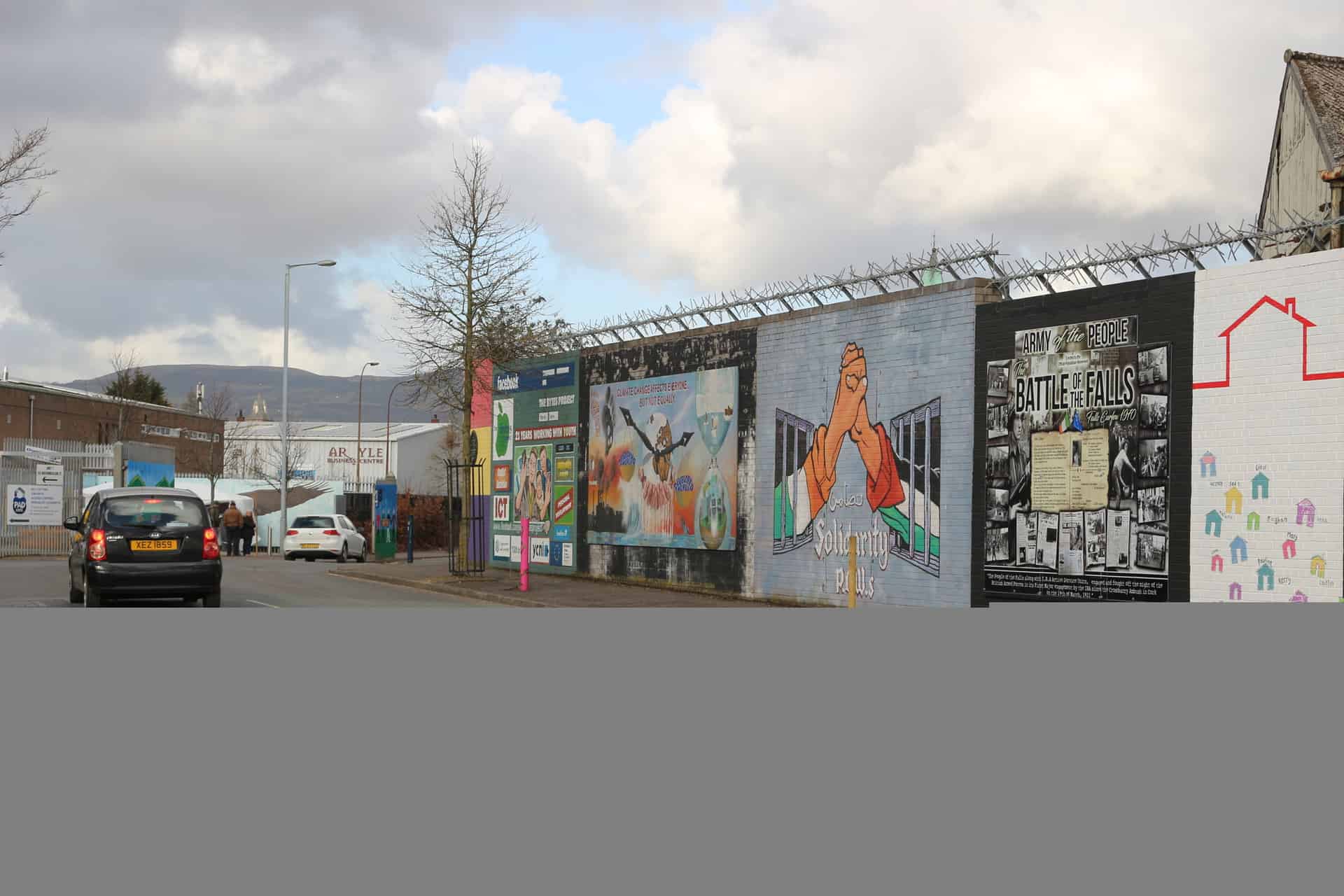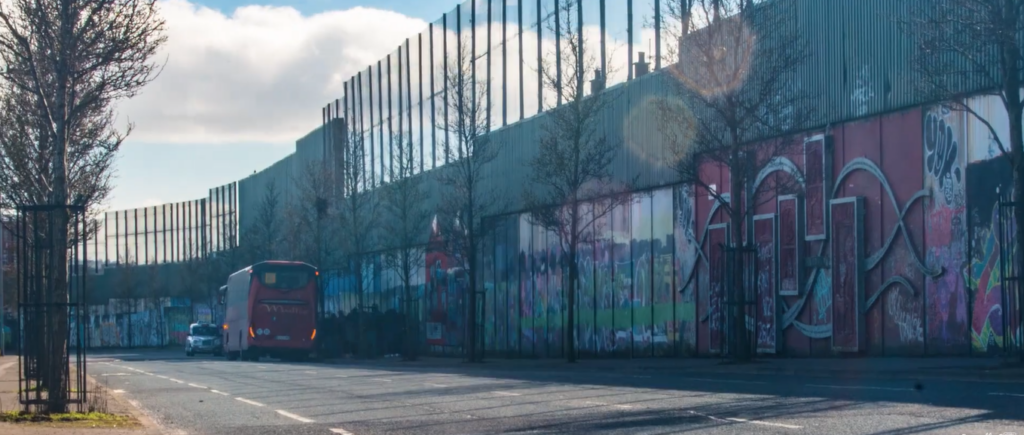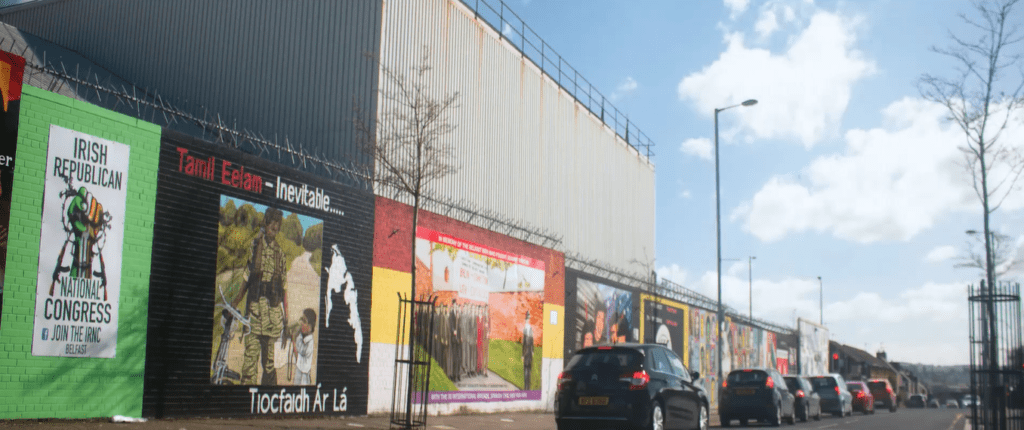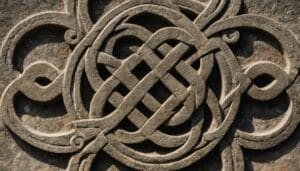Belfast Peace Walls – Amazing Murals and History in Belfast

Updated On: April 15, 2024 by Ciaran Connolly
The Belfast Peace Walls are full of amazing murals and history that tell an essential story of Belfast, The Troubles and why the Peace Walls were put in place. You can spend time reading the vast messages people have left on the Belfast Peace Walls worldwide; they are uplifting and inspiring.
Table of Contents
What is the Belfast Peace Walls?
The Belfast Peace Walls are barriers erected to separate Catholic and Protestant neighbourhoods in Northern Ireland. They are located in Belfast, Derry, Portadown, and elsewhere. The purpose of the peace lines was to minimise the violent interactions between Catholics (most of whom are nationalists who self-identify as Irish) and Protestants (most of whom are unionists who self-identify as British).
The Belfast Peace Walls range from a few hundred yards to over three miles. They may be made of iron, brick, and/or steel and are up to 25 feet high. Some walls have gates allowing passage during daylight hours, but they remain closed at night.
History of the Belfast Peace Walls
The first of the Belfast Peace Walls was built in 1969, following the 1969 Northern Ireland riots and “the Troubles” outbreak. They were initially meant to stay up for only six months, but they were later increased in number and spread through several locations. In recent years, they have even become somewhat of a tourist attraction.
In 2008, the possibility of removing the walls was discussed, and in 2011, Belfast City Council agreed to develop a strategy for removing the walls. Although a study indicated that 69% of residents believed that the peace walls should not be removed due to the continuing possibility of violence, several initiatives led by local communities resulted in the opening of several interface structures for a trial period.
In January 2012, the International Fund for Ireland launched a Peace Walls funding programme to support local communities in beginning to work on tearing down the peace walls. In May 2013, the Northern Ireland Executive committed to removing all peace lines by mutual consent by 2023.
The Conundrum of Tearing Down the Belfast Peace Walls
According to the Guardian, a secret report conducted by the Northern Irish government criticized the speed with which walls, gates and fences were being constructed in Belfast to separate Catholics and Protestants. The report claimed that the walls created an “atmosphere of abnormality” in the city.
Although the walls were constructed to bring a sense of “peace” and prevent any form of violence between both communities on either side, violence has persisted in some areas even after the construction of a barrier. Interface violence is rampant during the summer months when the marching season and the summer holidays start.
Recently, Jonny Byrne, a lecturer in politics at the University of Ulster, likened the Peace Walls to the Berlin Wall by saying, “The Berlin Wall had to come down for Berlin to be normalised. We have normalised Belfast without taking down the walls.”
Belfast Peace Walls

North Belfast witnessed some of the worst violence during The Troubles.
Some efforts to restore mobility between both sides of the fences have worked since 2011, when a “peace gate” was installed in the iron fence of Alexandra Park.
“The difficulty in any peace wall conversation is that many initial discussions revolve around a sense of loss. What will I lose? Ian McLaughlin of the Lower Shankill Community Association asks.
McLaughlin says the answer to Belfast’s peace wall conundrum lies in regeneration. “Our core business at one time was peace-building, but now we have a dual approach – regenerating our community and building relations with our neighbours.”
In August 2016, Belfast tore down its first peace wall 18 years after the Good Friday Agreement that brokered a peace deal for the region. By 2023, Northern Ireland’s 48 peace walls will be demolished.
American President Obama once addressed the issue to a crowd in Belfast, “There are walls that still stand; there are still many miles to go.” He added, “You have to remind us of hope again and again and again. Despite resistance, despite setbacks, despite hardship, despite tragedy, you have to remind us of the future again and again and again.”
Northern Ireland’s government wants to tear down every wall by 2023. However, to appease all parties involved, the process seems to need to be slow and gradual.
Dr Byrne, a University of Ulster academic, co-wrote a 2012 report on people’s attitudes to the walls. His report revealed that a total of 69% living near a wall would fear for their safety if it were ever torn down, while 58% say they would worry about the police’s ability to contain any resulting violence. But 58% also say they would like to see them come down “at some point in the future”.
Different places have different fears; Dr Byrne says, “Community safety, fear of being attacked. But also fear of the unknown. People don’t like to change. People are comfortable with what they know…[In] each community, the approach is different. In some communities, the walls mark where some families lost loved ones (during The Troubles). In others, there are concerns about anti-social behaviour and youth violence,” he says. “When you get down to the micro-level, it (removing the walls) becomes very difficult. None of this was envisaged when the British military put them up.”
Evolution of the Murals
Amidst the turmoil of the Troubles, the walls of Belfast became canvases for political expression, memorialization, and cultural identity. What began as crude slogans and territorial markings evolved into elaborate murals depicting scenes of historical significance, political messages, and calls for peace and reconciliation.
The murals on the Peace Walls reflect the diverse perspectives and experiences of the communities they represent. Themes range from commemorating fallen paramilitaries and celebrating cultural heritage to promoting messages of unity and hope for a better future. Artists from both sides of the sectarian divide have contributed to the murals, using their creativity to challenge stereotypes, provoke thought, and foster dialogue.
One of the most iconic murals is the “International Wall” on Falls Road. It features a vast array of political murals supporting causes from around the world alongside images commemorating local heroes and events. This mural serves as a testament to the global solidarity felt by many in Belfast during the Troubles. It continues to be a focal point for visitors seeking to understand the city’s complex history.
Another notable mural is “The Women’s Mural” on Divis Street, which pays homage to the vital role played by women in supporting their communities throughout the Troubles. Depicting women in various roles, from mothers comforting children to activists demanding justice, the mural serves as a powerful reminder of the resilience and strength of Belfast’s women in the face of adversity.
Significance and Legacy

As Northern Ireland continues its journey towards reconciliation and peacebuilding, the Belfast Peace Walls and their murals remain poignant symbols of the city’s troubled past and its aspirations for a shared future. While the physical barriers serve as a reminder of the divisions that once tore communities apart, the murals offer glimpses of hope, resilience, and the potential for transformation.
In recent years, there has been a growing movement to reimagine the Peace Walls as sites of cultural heritage, tourism, and community engagement. Initiatives such as guided mural tours, public art projects, and community events aim to break down literal and metaphorical barriers and promote dialogue, understanding, and reconciliation among Belfast’s diverse communities.
The future of the Peace Walls remains uncertain, with calls for their removal or transformation into more permeable structures gaining traction among some residents and policymakers. However, any decision regarding the fate of the walls must be approached with sensitivity and consideration for the complex legacies of the Troubles and the aspirations of the communities they serve.
The Peace Wall as a Tourist Attraction
According to the Huffington Post, the Peace Wall is one of Belfast’s top tourist attractions. Visitors enjoying bus or cab tours can stop by and are even encouraged to scrawl their messages on it.
Recently, visiting areas where historical conflicts have occurred has become increasingly popular with tourists, especially in Northern Ireland.
Shankill/Falls Peace Wall
The most popular peace wall tourist attraction is between the Shankill and Falls communities of West Belfast. The wall stretches between the communities and is one of the only peace walls in the country to have working roads running through it in the daytime. The streets are then closed at night-time, allowing no-through access to the other side under darkness.
On both sides of the peace wall, there are hundreds of murals. Many murals can be seen as Republican or Unionist, although, in more recent times, more and more murals are being changed to spread a more inclusive and positive message.
At the Falls/Shankill peace wall, everyone is encouraged to spread their positive message by being allowed to write on the wall itself. Tourists worldwide have visited the attraction and are encouraged to write their names if they don’t necessarily have a message to spread.
Many tours and most black taxi drivers in the Belfast City Center can take you to the different memorials and murals of West Belfast, and these tours will include this peace wall. So remember your marker pen to write your name or message.
Celebrations of the Beginning of a New Era
In August 2016, residents at a North Belfast interface held a celebration event to mark a new era after the Housing Executive removed a peace wall.
Housing Executive Chief Executive Clark Bailie said: “The Housing Executive’s role has been to enable the community to take this positive step and remove this physical and psychological barrier 30 years after it was first erected…This wall’s transformation will help regenerate the area for everyone in the community and change the physical environment and the lives of those who live behind it. It’s wonderful to see local families enjoying this new open space today.”
Related Events and Locations
- The Troubles
During the Troubles in 1969, a three-day battle against the RUC and local Protestants—widely known as the Battle of the Bogside—the Bogside area became a focal point of much of the events. The Bogside experienced frequent street riots and sectarian conflicts lasting until the early 1990s.
Throughout the rest of the 1990s, the Bogside became relatively peaceful compared to other localities of Northern Ireland at that time, such as Belfast, even though street riots were still frequent.
- Bloody Sunday
Bloody Sunday – also known as the Bogside Massacre – was an incident that took place on 30 January 1972 in the Bogside area. British soldiers shot 26 unarmed civilians during a peaceful protest march organized by the Northern Ireland Civil Rights Association and the Northern Resistance Movement against internment. Fourteen people died: thirteen were killed outright, while the death of another man was four months later due to his severe injuries. Many of the victims were shot as they fled from the bullets fired by soldiers, and some were shot as they tried to aid the wounded.
- Bogside Murals
The Bogside murals are the most famous in Northern Ireland and perhaps the most well-known political murals worldwide. Situated at Free Derry Corner, the Bogside Artists painted the murals. The Petrol Bomber mural was painted in 1994 to depict the ’Battle of the Bogside’, which took place in the Bogside area of Derry in August 1969. The mural portrays an image of a young boy wearing a gas mask to protect himself from the CS gas that the RUC used. He is also holding a petrol bomb, a standard weapon used by residents to deter the police and army from the area.
In Free Derry Corner, a slogan that says “You Are Now Entering Free Derry” was painted in 1969, not long after the Battle of the Bogside. Although not mainly considered a mural as it contains only words and no images, the Free Derry Corner has been used as a model for other murals in Northern Ireland, including the “You Are Now Entering Loyalist Sandy Row” mural in Belfast, which is considered as a form of response to the Republican message at Free Derry Corner.
We recommend going on a black taxi tour of the Belfast Peace Walls to dive further into the meaning and history of the walls. Local people from the two communities come together to deliver the black taxi tours.
Conclusion
The Belfast Peace Walls stand as enduring monuments to the resilience, creativity, and determination of the people of Northern Ireland to overcome division and build a more peaceful and inclusive society. As visitors gaze upon the captivating murals that adorn these barriers, they are reminded of the city’s troubled past and its potential for reconciliation, healing, and hope. In the words of one mural, “There is always hope,” this hope continues to inspire efforts to break down walls and build bridges towards a brighter future for Belfast and beyond.
Have you ever visited the Peace Walls? What do you think of them? We would love to know; comment below:)






